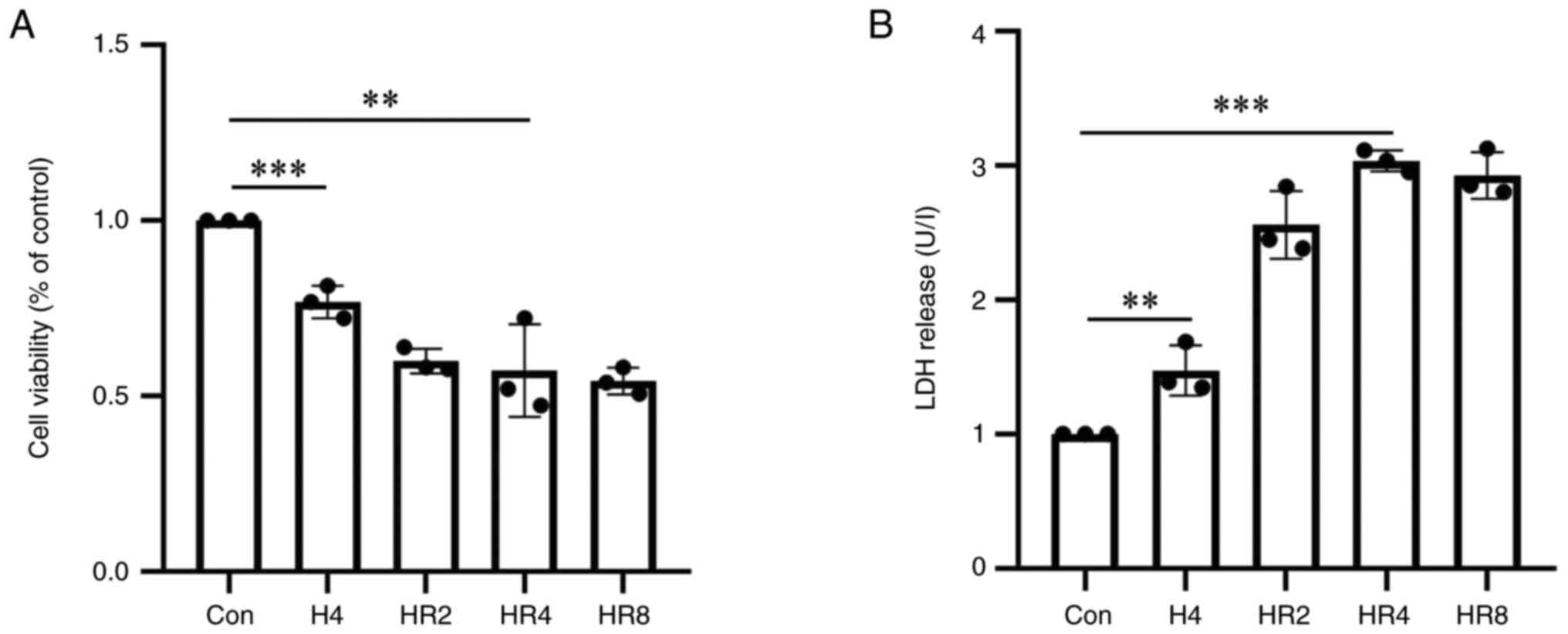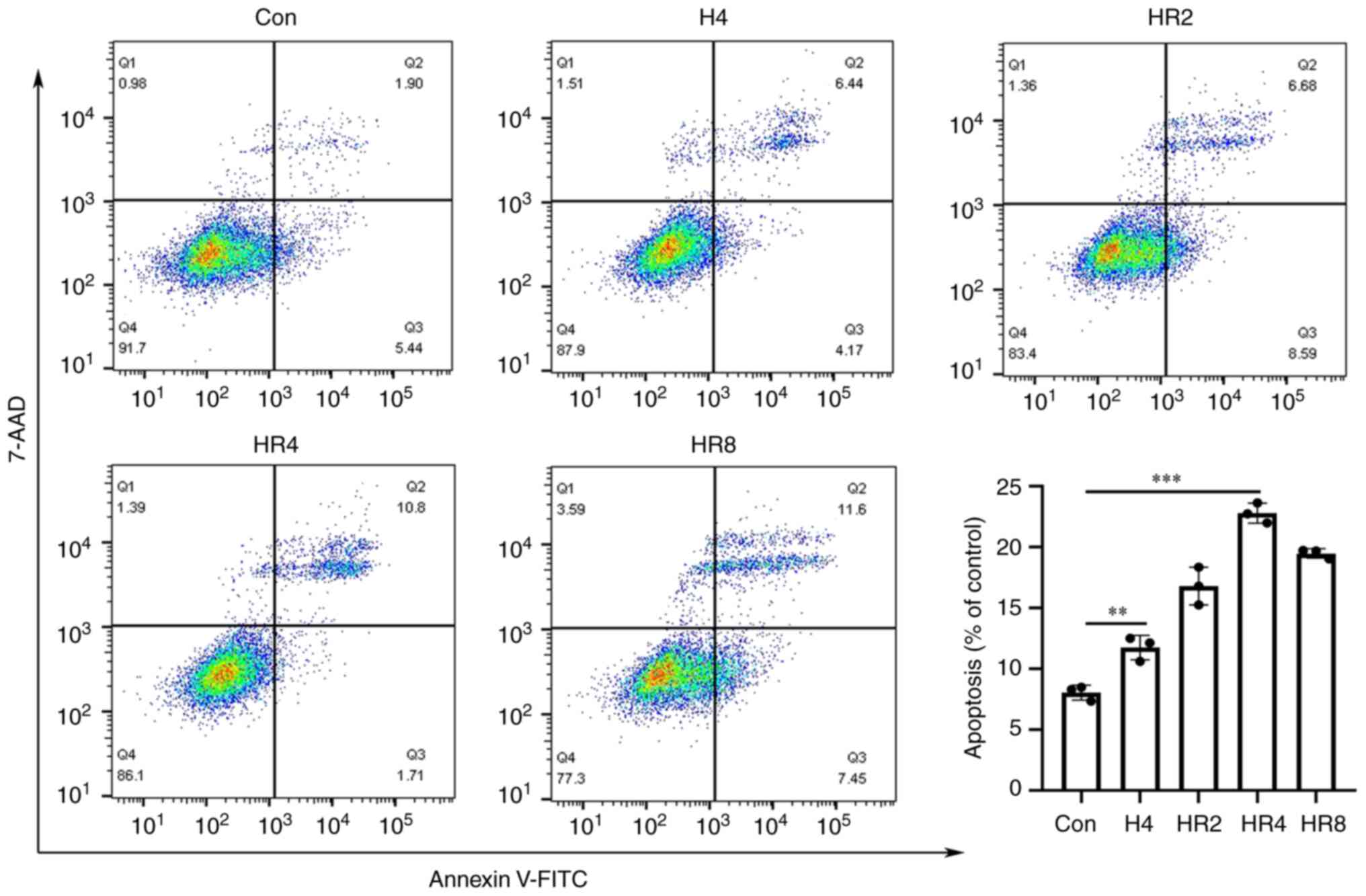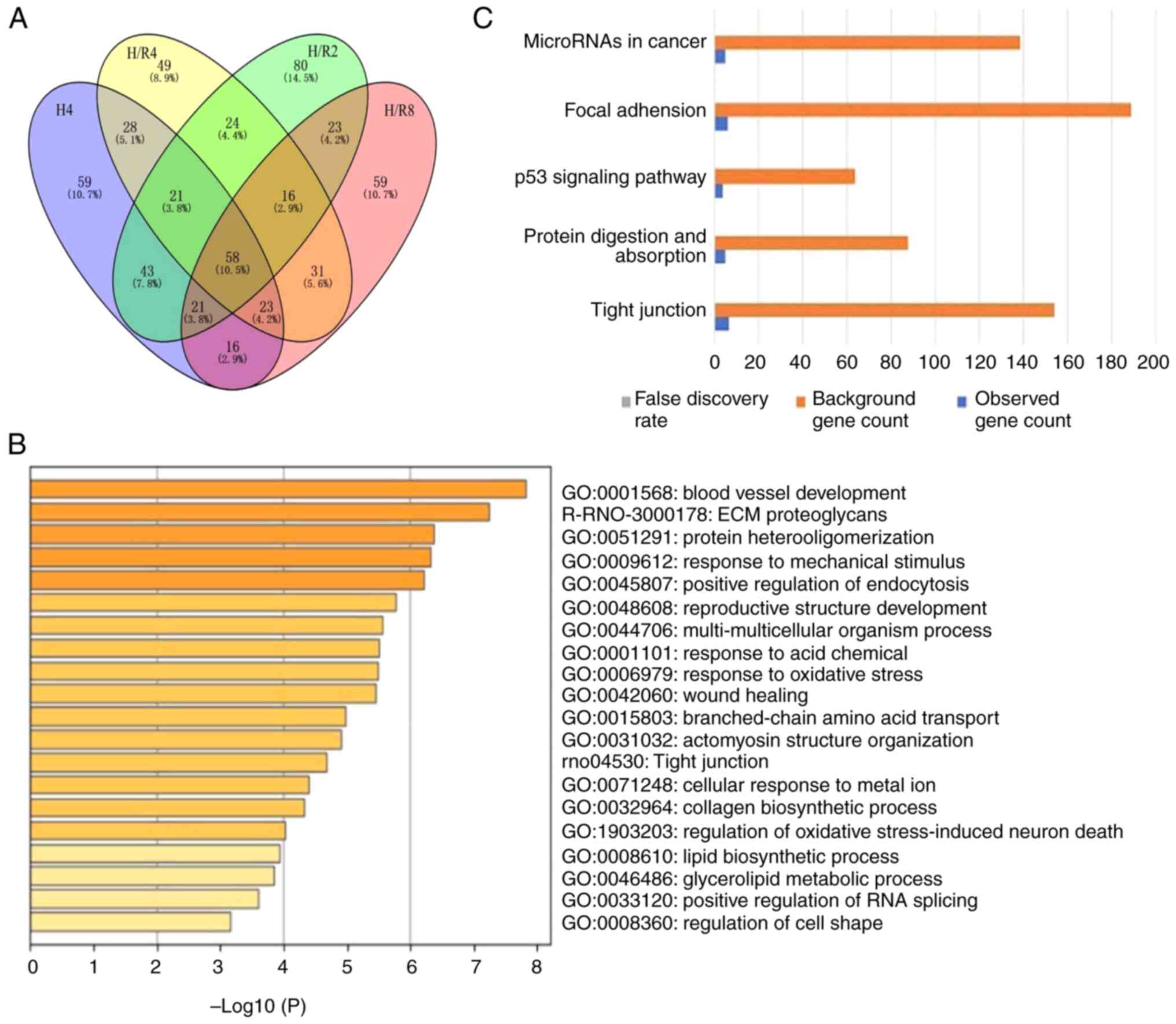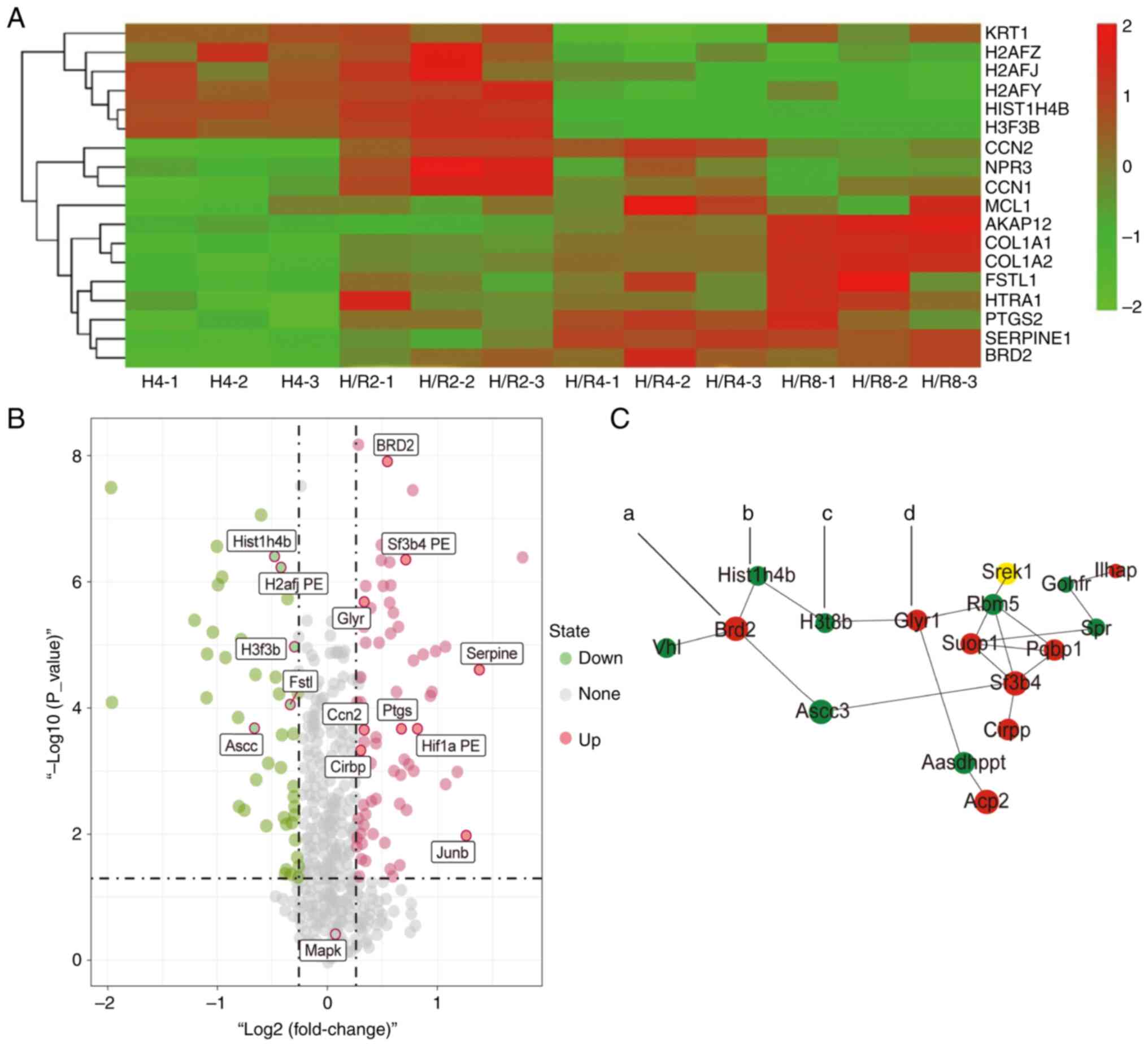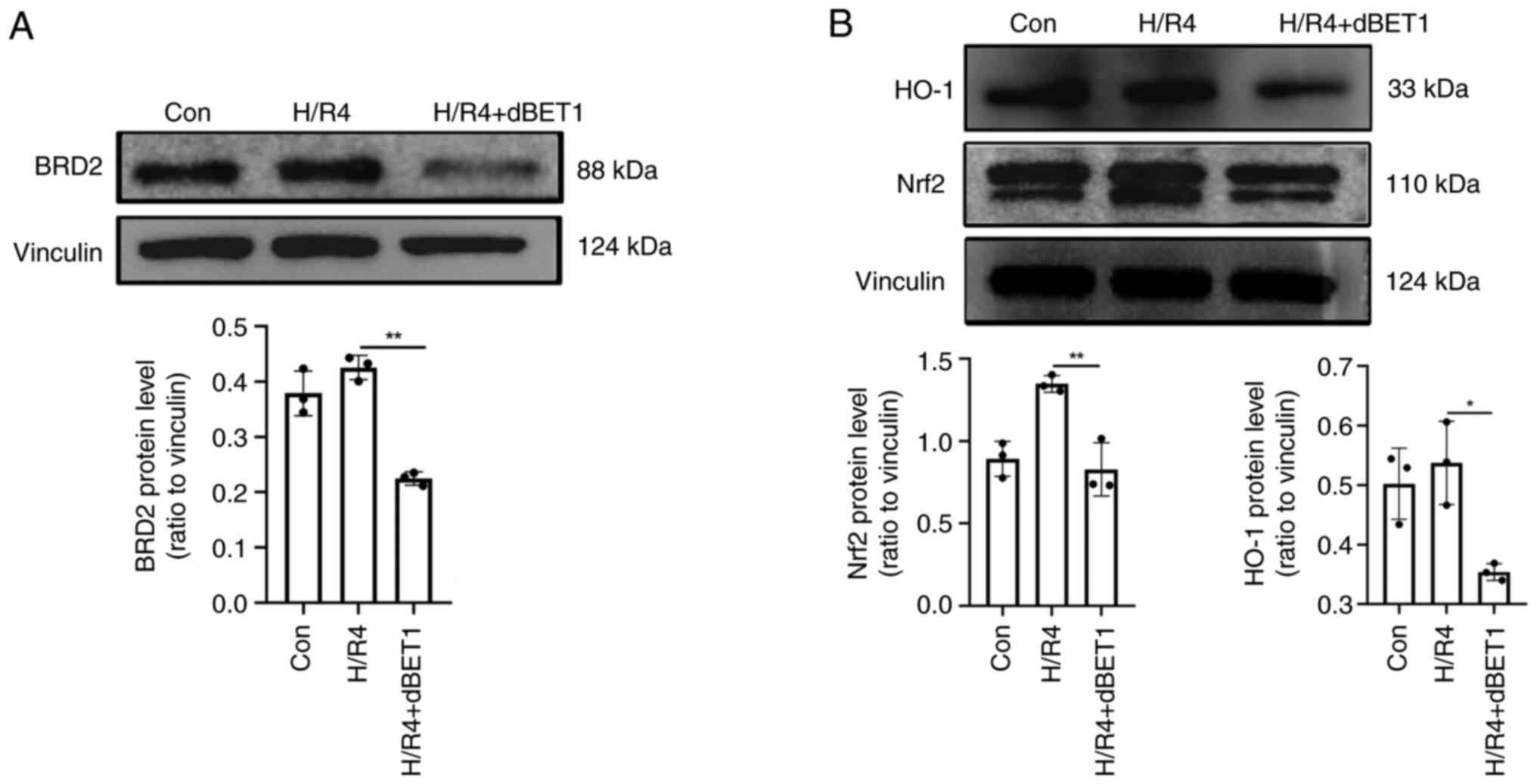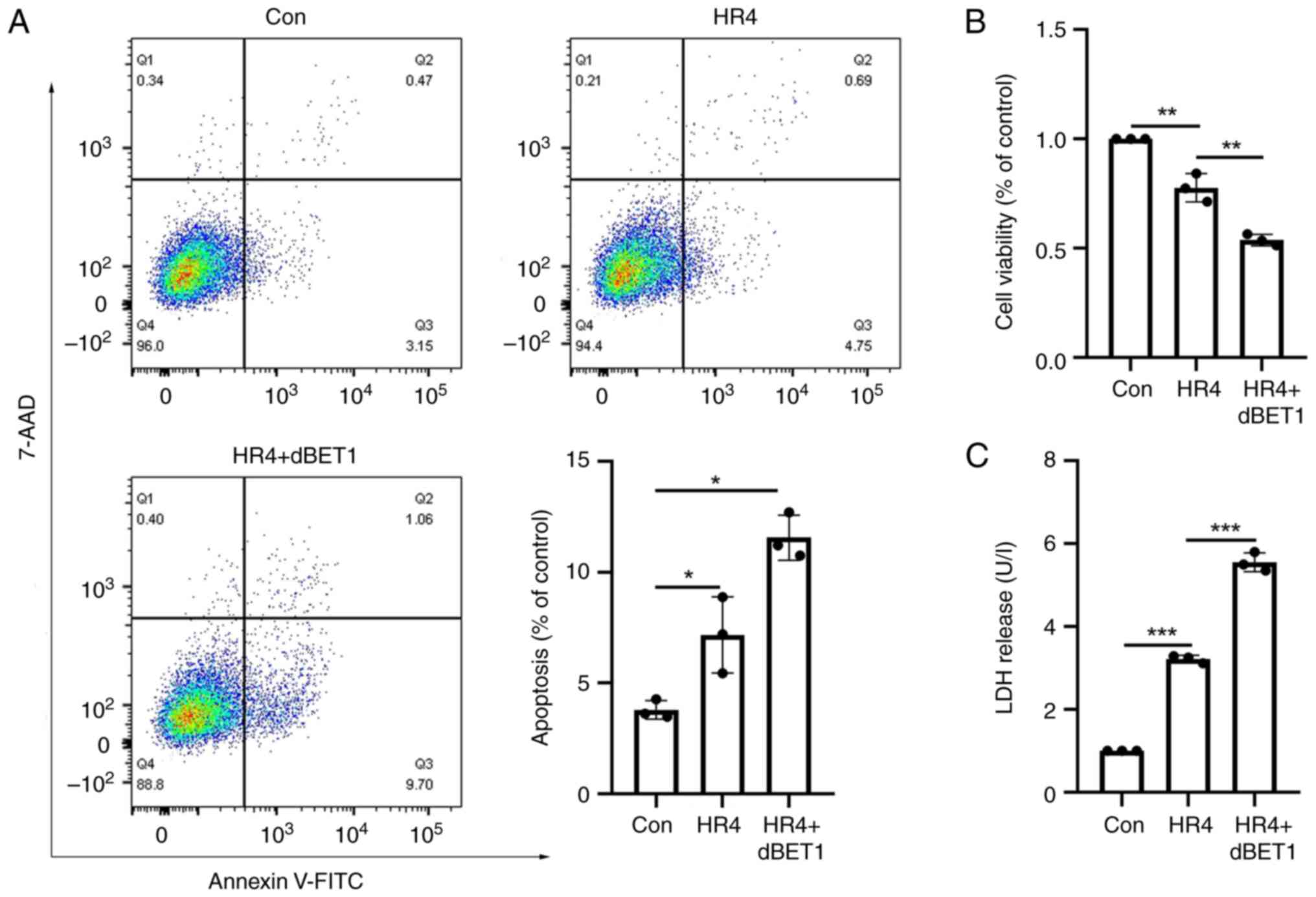BRD2 protects the rat H9C2 cardiomyocytes from hypoxia‑reoxygenation injury by targeting Nrf2/HO‑1 signaling pathway
- Authors:
- Published online on: October 4, 2023 https://doi.org/10.3892/etm.2023.12241
- Article Number: 542
-
Copyright: © Liu et al. This is an open access article distributed under the terms of Creative Commons Attribution License.
Abstract
Introduction
Acute myocardial infarction (AMI) is one of the deadliest diseases in the world (1,2). Although the extensive application of percutaneous coronary intervention (PCI) has improved the prognosis of AMI in recent years, abrupt reperfusion in the ischemic myocardium can lead to ischemia/reperfusion (I/R) injury in cardiomyocytes (3,4). However, the unclear mechanism of I/R injury limits the development of therapeutic strategies.
Studies have shown that the bromodomain (BRD)-containing protein family, including BRD2, BRD3, BRD4, BRD7 and BRD9, and the bromodomain, testis-specific (BRDT) protein (5), is associated with a variety of cardiovascular diseases. For instance, the upregulation of citrate cycle genes by BRD2 may facilitate cardiac hypertrophy (6). BRD4 is involved in myocardial infarction (7), cardiac hypertrophy (8) and even cardiac remodeling and functions (9,10). In addition, the myocardial infarction-induced myocardial injury is regulated by BRD7 through activating Wnt/β-catenin signaling (11). However, few studies have reported the role of the BRD family in myocardial I/R injury.
Thus, the objective of the present study was to investigate the role of the BRD family in myocardial I/R injury. Given that myocardial I/R injury is a condition involving a complex interplay of molecular mechanisms, such as intracellular calcium overload, oxidative stress, disturbance of energy metabolism, apoptosis, vascular endothelial injury and neutrophil infiltration (12-15), proteomics was performed to investigate the changes of all proteins in a certain type of cell at the protein level and reveal the biological function of BRDs more accurately than transcriptome analysis (16). The present study also used the tandem mass tag (TMT) labelling quantitative technique combined with liquid chromatography-tandem mass spectrometry (LC-MS/MS) to demonstrate the changes of all plasma proteins in myocardial cells during I/R injury. It is hoped that the present study could provide potential therapeutic targets by determining a possible relationship between the expression of BRDs and myocardial I/R injury. Understanding the relationship between BRD expression and cardiac damage can pave the way for the development of targeted interventions to protect cardiomyocytes following AMI. These insights may lead to novel treatment strategies aimed at improving patient outcomes in AMI.
Materials and methods
Cell lines and culture
Shanghai Cell Bank provided H9C2 cardiomyocytes with the serial number GNR 5. Cells were grown in At 37˚C with 5% CO2 in DMEM augmented with 10% FBS (Gibco; Thermo Fisher Scientific, Inc.), 10% streptomycin, and 1% penicillin (Thermo Fisher Scientific, Inc.).
Establishment of the cardiomyocyte hypoxia/reoxygenation model and experimental grouping
A hypoxia/reoxygenation (H/R) model was created by filling a Billups-Rothenberg hypoxic/anaerobic incubator with a mixture of 95% N2 and 5% CO2 (Chongqing Ruike Gas Co. Ltd.). Prior to the cells were treated with hypoxia, they were cultured in a medium (2 ml of DMEM) devoid of sugar and serum for 3 h with 5% CO2 at 37˚C. The H/R and hypoxia groups were then transferred to an anaerobic incubator containing a hypoxia gas mixture. The control group was also subjected to standard incubation conditions consisting of 5% CO2 and 37˚C. The six-well plates were taken away from the hypoxia for 4 h, and their original medium was swapped out for the sugared medium. After that, the cells spent time in a 5% CO2 incubator at 37˚C for 2, 4, and 8 h to re-oxygenate. The abbreviation ‘H4’ was used to represent hypoxia for 4 h, and the abbreviations ‘H/R2’ ‘H/R4’ and ‘H/R8’ used to represent hypoxia for 4 h and then reoxygenation for 2, 4, and 8 h, respectively.
Detection of the cell survival rate by CCK8
After cells were adhered for a day, both groups were cultured normally in a 5% CO2 cell incubator, but the experimental group also received H/R treatment as described above. Cells in each group were treated with CCK-8 reaction solution following hypoxia and H/R, and incubated at 37˚C for 1 h, in accordance with the instructions provided in the CCK-8 test kit. The OD values were determined by analyzing the microplates at 450 nm.
LDH release from H9C2 cardiomyocytes was analyzed using LDH release assays
Following the establishment of the H/R paradigm, the cell supernatants were collected, and LDH in cardiomyocytes was quantified as directed by the manufacturer of the LDH kit (Nanjing Jian Cheng Bioengineering Institute; cat. no. A020-2).
Detection of apoptosis by flow cytometry
Following the establishment of a suitable H/R model, the cell cycle analysis was performed on a fluorescence-activated cell sorting flow cytometer (BD FACSCalibur; BD Biosciences). The cells were resuspended in DMEM. Annexin V FITC (20 g/ml) and propidium (PI) (50 µg/ml) in 100 µl Annexin V binding buffer were added to the cells and incubated for 15 min at 4˚C in the dark. The flow cytometer was used to analyze the samples for apoptosis. FlowJo v10.0 (FlowJo LLC) and fluorescence-activated cell sorting were used to analyze the data and calculate the proportion of apoptotic cells. The total apoptotic rate was calculated as the early apoptotic rate plus the late apoptotic rate.
Tandem mass tag (TMT) isobaric labelling
After the cardiomyocytes were washed with PBS, they were lysed using RIPA buffer. The protein concentration was measured by a BCA protein assay kit. Filter-aided sample preparation was used to digest 100 µg of proteins. The control group, hypoxia for 4 h and reoxygenation for 2, 4, and 8 h groups were labelled with 126, 127, 128, 129, and 130 Th, respectively, and the reoxygenation for 4 h group was labelled again with 131 Th. The samples were separated into eight fractions by pH12 reversed-phase chromatography. An Easy-nanoLC1000 liquid chromatograph and an LTQ Orbitrap Velos mass spectrometer (Thermo Fisher Scientific, Inc.) were used for proteomic analyses. The Swiss-Prorat database's differential proteins (Homo sapiens, release 2020_06; www.uniprot.org) were compared and screened using Protein Discovery Software 1.4 (Thermo Fisher Scientific, Inc.).
The Z-test was utilized to identify proteins with statistically significant changes in abundance (P<0.05) and then the significance of the hit was used to filter out proteins with 1.2-fold changes. Proteomics findings were uploaded to STRING (https://string-db.org/). Kyoto Encyclopedia of Genes and Genomes (KEGG) 2.4.1 (www.genome.jp/kegg/) was used to discover protein pathways. The identified proteins were evaluated using Gene Ontology (GO) terms in Metascape (https://metascape.org/).
Analysis of the cell proteome
The Proteome Discoverer 21 (Thermo Fisher Scientific, Inc.) program transformed the proteome data, which was then loaded into Mascot 2.2.0. algorithm (Matrix Science Ltd.) for retrieval. After exporting the data, the expression matrix containing all genes and phenotypes of the samples was subjected to Gene Set Enrichment Analysis (GSEA) software (version 4.0.3, Broad Institute) for the analysis of GO enrichment. Additionally, for a functional-level analysis of the differentially expressed genes, the present study utilized the Metascape database (https://metascape.org), an online tool that facilitates the annotation, visualization, and integrated discovery of gene lists (17). Through this tool, it was possible to gain functional insights into the GO enrichment and KEGG pathway analysis for the differentially expressed genes.
Western blotting
After observing a significant decrease in cell viability, an increase in LDH release and higher apoptotic rates in the H/R4 group compared to the other groups, the present study mainly concentrated on examining the expression of BRD2 in the H/R4 group. Total protein of H/R4 group was recovered from isolated cardiomyocytes using standard methods and RIPA buffer. The protein concentration was determined with a BCA protein kit. Each lane contained 40 µg of protein that had been separated using 10% SDS-PAGE and then transferred to a polyvinylidene fluoride membrane (MilliporeSigma). The membranes were blocked for 2 h of room temperature with Tris-buffered saline containing 0.1% Tween 20, including 5% nonfat milk (TBST). Finally, the membranes were treated with anti-BRD2 (1:1,000; cat. no. 139690; Abcam) and anti-nuclear factor erythroid 2-related factor 2 (Nrf2) (1:1,000; cat. no. 13901; Cell Signaling Technology) and anti-Vinculin (1:1,000; cat. no. 16396-1-AP; Proteintech Group, Inc.) at 4˚C overnight. Membranes were incubated with an HRP-conjugated goat anti-rabbit or anti-mouse IgG secondary antibody for 1 h at room temperature after the primary antibody incubation (1:500; Cell Signaling Technology). The detection was made using a Bio-Rad ChemiDoc MP Imaging System (Bio-Rad Laboratories, Inc.).
Determination of the effective concentration of dBET1
dBET1 is a proteolysis-targeting chimera that can result in selective degradation of BET proteins (18). In order to delve deeper into the regulatory pathway indicated in the proteomics of BRD2, the expression of haem oxygenase-1 (HO-1) and Nrf2 before and after the administration of dBET1 was investigated. For the concentration-response experiment, 2x105 cells were cultured in 2 ml DMEM containing 20 nM dBET1 (Selleck Chemicals). The cells were cultivated in an incubator containing 5% CO2 at 37˚C for 48 h and oxygen-deprived for 4 h in a Billups-Rothenberg hypoxic/anaerobic incubator containing a mixture of gases (95% N2, 5% CO2). Then, western blotting was used to determine the BRD2 protein expression. At a dose of 20 nM, the expression of BRD2 was markedly suppressed. This concentration was used for the subsequent experiment. Furthermore, the cell viability, LDH release, and apoptotic rates in the H/R4 group after the administration of dBET1 were also detected, using the same previously mentioned methods.
Statistical analysis
All statistical analyses were performed with SPSS 21.0 (IBM Corp.). The figures indicate the mean and standard deviation of the mean (SD). Differences among three groups were analyzed using one-way analysis of variance (ANOVA) followed by Tukey's post-hoc test using GraphPad Prism software, as specified in the figure legends. P<0.05 was considered to indicate a statistically significant difference.
Results
Establishment of the (H/R) model
The CCK-8 results revealed a reduction in cell survival as reoxygenation time increased (Fig. 1A). The difference in cell survival rates between the control group and the 4 h reoxygenation group was statistically significant (P<0.01). The LDH results indicated that as reoxygenation time increased, cell damage was exacerbated. In terms of cell damage, the difference between the 4 h reoxygenation group and the control group was statistically significant (P<0.001; Fig. 1B). Flow cytometry demonstrated that the apoptosis rate of the 4 h hypoxia group was significantly higher than that of the control group (P<0.01; Fig. 2) and that the apoptotic rate rose as reoxygenation time increased. The difference in the apoptotic rate between the 4 h reoxygenation group and the control group was statistically significant (P<0.001; Fig. 2). It was determined that 4 h of hypoxia and 4 h of reoxygenation were ideal for the development of cardiomyocytes.
Screening and global analysis of significantly different proteins in the H/R4 group
A total of 2,325 significantly differentially expressed proteins were identified by TMT labelling combined with reverse-phase liquid chromatography (RP-HPLC). Using a bioinformatics method, the proteins of each experimental group were screened according to the standard of fold change >1.2 or <0.8 and P-value (t-test) <0.05. As shown in Fig. 3A, compared with the normal control group, there were 267 significantly different proteins under hypoxia for 4 h, 286 significantly different proteins under H/R2, 250 significantly different proteins under H/R4, and 247 significantly different proteins under H/R8. Among them, 119 proteins were involved in the process of hypoxia and reoxygenation. A total of 49 proteins appeared in H/R4 but were not involved in the process of simple hypoxia for 4 h.
Analysis of the effects of the significant differentially expressed proteins in the H/R4 group
The present study identified 250 significantly differentially expressed proteins (Fig. 3B and C) in the H/R4 group concerning the GO and KEGG databases. The GO analysis results were as follows: Among biological processes, the differentially expressed protein functions were involved in regulating nucleic acid metabolism, vascular development, lipid metabolism and metal ion transport among others. Among molecular functions, the protein functions were mainly focused on regulating enzyme molecular functions. In the cellular component category, these differentially expressed proteins were mainly distributed in the cytoplasm, endometrium system, and extracellular gap. KEGG analysis showed that differentially expressed proteins resulting from myocardial injury induced by H/R were correlated with tight junctions, protein degradation pathways and signaling pathways among others.
Cluster analysis of differentially expressed proteins in the H/R4 group
The protein cluster analysis findings (Fig. 4A and B) revealed that the histone family proteins H2AFZ, H2AFJ and H2AFY increased during hypoxia and reduced following reoxygenation. Histone H3 (H3F3B) expression also rose during hypoxia and dropped following reoxygenation, while the expression levels of Ptsg2, Serprine1 and Junb proteins fell during hypoxia for 4 h and increased following reoxygenation for 4 h. In the heat map analysis, which resembled the volcano plot of the protein screening, protein clustering was evident. The protein interaction network map (Fig. 4C) revealed that in H/R4, the H3F3B expression was dramatically reduced and the BRD2 expression was significantly enhanced compared to the control group. The increased protein Glyr was consistent with the volcano plot.
Overexpression of BRD2 regulated by Nrf2/HO-1 signaling pathway in H/R4 group
Western blot analysis revealed that the expression of BRD2 was dramatically increased after 4 h of exposure to hypoxia and reoxygenation, corroborating the protein cluster analysis. In addition, when the BRD protein inhibitor dBET1 was added, the expression of BRD2 fell dramatically (P<0.01; Fig. 5A). This H/R mechanism was related to the Nrf2/HO-1 signaling pathway, and dBET1 reversed the upregulation (Fig. 5B).
Effects of BRD2 protein inhibition on cardiomyocyte's apoptosis, cell viability, and release of LDH
Flow cytometry analysis revealed that, relative to the control group, cardiomyocyte apoptosis was elevated in the H/R4 group and in the H/R4 group following administration of the BRD2 inhibitor dBET1 (P<0.05; Fig. 6A). Using the CCK-8 assay, it was also determined that the addition of dBET1 significantly lowered cell viability (P<0.01; Fig. 6B). After addition of dBET1, the release of LDH was enhanced (P<0.001; Fig. 6C).
Discussion
To the best of the authors' knowledge, this is the first study to demonstrate that BRD2 can protect cardiomyocytes from H/R-induced damage by targeting the Nrf2/HO-1 signaling pathway. In addition, the present study enhanced the existing knowledge of the mechanism of myocardial I/R damage from the viewpoint of proteomics and revealed the relevance of BRD2 as a possible therapeutic target.
Multiple signaling pathways have been linked to the process of myocardial I/R damage (19-22), but there are still no suitable interventions to alleviate I/R injury during cardiac surgery due to the poor understanding of proteome changes caused by the lack of high-throughput protein detection technology. Given that the pathophysiological process of H/R damage in cardiomyocytes is comparable with that of myocardial I/R injury, a cardiomyocyte H/R model was developed to replicate the myocardial I/R process. TMT labeling in conjunction with HPLC was used to identify alterations in the proteome of H9C2 cardiomyocytes and a total of 2325 proteins with differential expression were discovered. Through a proteomic analysis, Li et al (19) demonstrated that when human cardiac microvascular endothelial cells were subjected to I/R injuries, the expression of 30 proteins changed, highlighting their potential roles in cell proliferation, stress response, and regulation of metabolic process upon I/R injury. The present study also conducted in-depth information mining of proteins related to intimal system changes with the development of vesicle transport and exosome technology, such as Junb, Fstl1, Kert1, H3f3b, Ptgs2, Hif1α, Hist1h4b, BRD2, Serpine1, and Glyr. The GO functional analysis revealed that these proteins can regulate vascular development, metal ion transport, and LDL lipid metabolism, suggesting their potential targets for reducing myocardial I/R injury (23-25). These results were consistent with the previous research. For instance, it has been demonstrated that Fstl1 is a cardioprotective factor regulated by Akt to reduce the myocardial I/R injury (26). In addition, inhibition of Fstl1 expression can aggravate cardiomyocyte apoptosis in myocardial H/R injury (27).
The BRD family serves as epigenetic ‘readers’ by recognizing acetylated histones and recruiting transcriptional regulator complexes to chromatin in order to regulate gene transcription (28). Due to the extensive role of the BRD family in cardiovascular diseases, the present study explored the role of BRD2 in H/R4. When the BRD2 protein inhibitor dBET1 was performed in the H/R4 group, a decrease was found in cell viability and an increased level in LDH release and apoptosis in cardiomyocytes, indicating BRD2 may play a protective role in myocardial I/R injury. A previous study also found that the absence of BRD2 can decrease heart function and increase the mortality of conditional knock-out mice after pressure overload (29). In addition, the expression of BRD2 is lower in the adult heart than in the fetal heart, indicating its role in heart development and heart disease (7).
In addition, the present study discovered that proteins in the Nrf2/HO-1 signaling pathway reduced following the addition of dBET1, indicating that BRD2 plays a significant protective function through this pathway. Numerous studies have also established that this pathway plays a crucial role in the control of homeostasis by modifying calcium levels to inhibit autophagy, ferroptosis and clockophagy (30-32). Regarding cardiovascular illnesses, activation of the Nrf2/HO-1 pathway might enhance the prognosis following a myocardial infarction damage through nuclear translocation and overexpression of antioxidative genes (33). In addition, arrhythmias may be alleviated by activating the NO route through the Nrf2/HO-1 signaling axis (34). The activation of this pathway plays a crucial role in myocardial remodeling (35). The method by which BRD2 contributes to cardiac H/R damage through stimulation of the Nrf2/HO-1 signaling pathway may thus present a unique therapeutic target for the treatment of I/R injury in cardiomyocytes, as shown by the present findings.
Nevertheless, there were a few shortcomings associated with the present study. First, it was conducted in isolated cell experiments and therefore limits interpretations of the results. Second, BRD2-related agonists have not been found so far, so the role of the overexpression of BRD2 in I/R injury of cardiomyocytes has remained to be fully elucidated. Further pharmacological studies and animal studies are still warranted to validate the conclusions of the present study.
The present study was the first to show, to the best of the authors' knowledge, the sequential proteome alterations that occur in cardiomyocytes throughout the H/R process. It discovered a critical protective function for BRD2 in I/R damage to cardiomyocytes and demonstrated the connection to the Nrf2/HO-1 signaling pathway. It represented a new target for the treatment of I/R injuries of cardiomyocytes and provides an opportunity to initiate timely interventions following PCI procedures.
Acknowledgements
Not applicable.
Funding
Funding: The present study was supported by the Natural Science Foundation of Chongqing (grant no. cstc2014jcyjA10071), the Science Foundation of Southwest Hospital (grant no. SWH2016JCYB-57) and the National Science Foundation of China (grant no. 81370446).
Availability of data and materials
All datasets generated or analyzed during the present study are available from the corresponding author upon reasonable request.
Authors' contributions
YL and LS conceived the present study. YL performed data curation. Conception and design was the responsibility of YL, YF and XX. YF and XX were responsible for the analysis and interpretation of data. LS and GT were responsible for supervision and project administration, and writing, reviewing and editing the manuscript. Visualization was the responsibility of XX. YL wrote the original draft of the manuscript. LS was responsible for funding acquisition. YL, GT and LS confirm the authenticity of all the raw data. All authors read and approved the final manuscript.
Ethics approval and consent to participate
Not applicable.
Patient consent for publication
Not applicable.
Competing interests
The authors declare that they have no competing interests.
References
|
Reed GW, Rossi JE and Cannon CP: Acute myocardial infarction. Lancet. 389:197–210. 2017.PubMed/NCBI View Article : Google Scholar | |
|
Lv J, Zhao Q, Yang J, Gao X, Zhang X, Ye Y, Dong Q, Fu R, Sun H, Yan X, et al: Length of stay and short-term outcomes in patients with ST-Segment elevation myocardial infarction after primary percutaneous coronary intervention: Insights from the China acute myocardial infarction registry. Int J Gen Med. 14:5981–5991. 2021.PubMed/NCBI View Article : Google Scholar | |
|
Algoet M, Janssens S, Himmelreich U, Gsell W, Pusovnik M, Van den Eynde J and Oosterlinck W: Myocardial ischemia-reperfusion injury and the influence of inflammation. Trends Cardiovasc Med. 33:357–366. 2023.PubMed/NCBI View Article : Google Scholar | |
|
Chen X, Rong C, Qi P, Bai W, Yao W, Zhang Y and Dang Y: LDL-C and total stent length are independent predictors of periprocedural myocardial injury and infarction for unstable angina patients undergoing elective percutaneous coronary intervention. Int J Gen Med. 14:1357–1365. 2021.PubMed/NCBI View Article : Google Scholar | |
|
Fujisawa T and Filippakopoulos P: Functions of bromodomain-containing proteins and their roles in homeostasis and cancer. Nat Rev Mol Cell Biol. 18:246–262. 2017.PubMed/NCBI View Article : Google Scholar | |
|
Lin Z and Li Z, Guo Z, Cao Y, Li J, Liu P and Li Z: Epigenetic reader bromodomain containing protein 2 facilitates pathological cardiac hypertrophy via regulating the expression of citrate cycle genes. Front Pharmacol. 13(887991)2022.PubMed/NCBI View Article : Google Scholar | |
|
Sun Y, Xie Y, Du L, Sun J and Liu Z: Inhibition of BRD4 attenuates cardiomyocyte apoptosis via NF-κB pathway in a rat model of myocardial infarction. Cardiovasc Ther. 36:2018.PubMed/NCBI View Article : Google Scholar | |
|
Wang Q, Sun Y, Li T, Liu L, Zhao Y, Li L, Zhang L and Meng Y: Function of BRD4 in the pathogenesis of high glucose-induced cardiac hypertrophy. Mol Med Rep. 19:499–507. 2019.PubMed/NCBI View Article : Google Scholar | |
|
Kim SY, Zhang X, Schiattarella GG, Altamirano F, Ramos TAR, French KM, Jiang N, Szweda PA, Evers BM, May HI, et al: Epigenetic Reader BRD4 (Bromodomain-Containing Protein 4) governs nucleus-encoded mitochondrial transcriptome to regulate cardiac function. Circulation. 142:2356–2370. 2020.PubMed/NCBI View Article : Google Scholar | |
|
Padmanabhan A, Alexanian M, Linares-Saldana R, González-Terán B, Andreoletti G, Huang Y, Connolly AJ, Kim W, Hsu A, Duan Q, et al: BRD4 (Bromodomain-Containing Protein 4) Interacts with GATA4 (GATA Binding Protein 4) to govern mitochondrial homeostasis in adult cardiomyocytes. Circulation. 142:2338–2355. 2020.PubMed/NCBI View Article : Google Scholar | |
|
Chi X, Shan L, Hu Y, Zhang Y, Mao Y and Wang X: Bromodomain-containing protein 7 contributes to myocardial infarction-induced myocardial injury through activating Wnt/β-catenin signaling. Ann Palliat Med. 10:10756–10767. 2021.PubMed/NCBI View Article : Google Scholar | |
|
Schirone L, Forte M, D'Ambrosio L, Valenti V, Vecchio D, Schiavon S, Spinosa G, Sarto G, Petrozza V, Frati G and Sciarretta S: An overview of the molecular mechanisms associated with myocardial ischemic injury: State of the art and translational perspectives. Cells. 11(1165)2022.PubMed/NCBI View Article : Google Scholar | |
|
Chen R, Zhou M and Zhu F: Immune checkpoint inhibitors related to cardiotoxicity. J Cardiovasc Dev Dis. 9(378)2022.PubMed/NCBI View Article : Google Scholar | |
|
Pertiwi KR, Hillman RM, Scott CA and Chilton EL: Ischemia reperfusion injury produces, and ischemic preconditioning prevents, rat cardiac fibroblast differentiation: Role of KATP channels. J Cardiovasc Dev Dis. 6(22)2019.PubMed/NCBI View Article : Google Scholar | |
|
Xie LH, Fefelova N, Pamarthi SH and Gwathmey JK: Molecular mechanisms of ferroptosis and relevance to cardiovascular disease. Cells. 11(2726)2022.PubMed/NCBI View Article : Google Scholar | |
|
Kustatscher G, Collins T, Gingras AC, Guo T, Hermjakob H, Ideker T, Lilley KS, Lundberg E, Marcotte EM, Ralser M and Rappsilber J: Understudied proteins: Opportunities and challenges for functional proteomics. Nat Methods. 19:774–779. 2022.PubMed/NCBI View Article : Google Scholar | |
|
Zhou Y, Zhou B, Pache L, Chang M, Khodabakhshi AH, Tanaseichuk O, Benner C and Chanda SK: Metascape provides a biologist-oriented resource for the analysis of systems-level datasets. Nat Commun. 10(1523)2019.PubMed/NCBI View Article : Google Scholar | |
|
DeMars KM, Yang C, Castro-Rivera CI and Candelario-Jalil E: Selective degradation of BET proteins with dBET1, a proteolysis-targeting chimera, potently reduces pro-inflammatory responses in lipopolysaccharide-activated microglia. Biochem Biophys Res Commun. 497:410–415. 2018.PubMed/NCBI View Article : Google Scholar | |
|
Li Q, Cui HH, Yang YJ, Li XD, Chen GH, Tian XQ, Jin C, Dong QT, Huang PS and Xu J: Quantitative proteomics analysis of ischemia/reperfusion injury-modulated proteins in cardiac microvascular endothelial cells and the protective role of tongxinluo. Cell Physiol Biochem. 41:1503–1518. 2017.PubMed/NCBI View Article : Google Scholar | |
|
Anzell AR, Maizy R, Przyklenk K and Sanderson TH: Mitochondrial quality control and disease: Insights into ischemia-reperfusion injury. Mol Neurobiol. 55:2547–2564. 2018.PubMed/NCBI View Article : Google Scholar | |
|
Davidson SM, Adameová A, Barile L, Cabrera-Fuentes HA, Lazou A, Pagliaro P, Stensløkken KO and Garcia-Dorado D: EU-CARDIOPROTECTION COST Action (CA16225). Mitochondrial and mitochondrial-independent pathways of myocardial cell death during ischaemia and reperfusion injury. J Cell Mol Med. 24:3795–3806. 2020.PubMed/NCBI View Article : Google Scholar | |
|
Bacci MR, Vasconcelos LY, Murad N, Chagas ACP, Capuano AC, Alves BC, Pereira EC, Azzalis LA, Junqueira VB and Fonseca F: Remote ischemic preconditioning in myocardial protection in hemodialysis patients. Int J Gen Med. 11:175–178. 2018.PubMed/NCBI View Article : Google Scholar | |
|
Yang L, Zhang Y, Zhu M, Zhang Q, Wang X, Wang Y, Zhang J, Li J, Yang L, Liu J, et al: Resveratrol attenuates myocardial ischemia/reperfusion injury through up-regulation of vascular endothelial growth factor B. Free Radic Biol Med. 101:1–9. 2016.PubMed/NCBI View Article : Google Scholar | |
|
Li W, Feng G, Gauthier JM, Lokshina I, Higashikubo R, Evans S, Liu X, Hassan A, Tanaka S, Cicka M, et al: Ferroptotic cell death and TLR4/Trif signaling initiate neutrophil recruitment after heart transplantation. J Clin Invest. 129:2293–2304. 2019.PubMed/NCBI View Article : Google Scholar | |
|
Lenarczyk M, Su J, Haworth ST, Komorowski R, Fish BL, Migrino RQ, Harmann L, Hopewell JW, Kronenberg A, Patel S, et al: Simvastatin mitigates increases in risk factors for and the occurrence of cardiac disease following 10 Gy total body irradiation. Pharmacol Res Perspect. 3(e00145)2015.PubMed/NCBI View Article : Google Scholar | |
|
Oshima Y, Ouchi N, Sato K, Izumiya Y, Pimentel DR and Walsh K: Follistatin-like 1 is an Akt-regulated cardioprotective factor that is secreted by the heart. Circulation. 117:3099–3108. 2008.PubMed/NCBI View Article : Google Scholar | |
|
Li KS, Jiang WP, Li QC, Zhang HW, Bai Y, Zhang X and Li HY: MiR-29a in mesenchymal stem cells inhibits FSTL1 secretion and promotes cardiac myocyte apoptosis in hypoxia-reoxygenation injury. Cardiovasc Pathol. 46(107180)2020.PubMed/NCBI View Article : Google Scholar | |
|
Gokani S and Bhatt LK: Bromodomains: A novel target for the anticancer therapy. Eur J Pharmacol. 911(174523)2021.PubMed/NCBI View Article : Google Scholar | |
|
Lbik D, Khadjeh S, Mohamed BA, Fischer A, Hasenfuß G and Toischer K: Abstract 20724: The absence of the chromatin reader Brd2 decreases heart function and increases mortality after pressure overload. Circulation. 136(A20724)2017. | |
|
Zhao Y, Liu X, Fu X, Mo Z, Jiang Y and Yan Y: Protective effects of epigallocatechin gallate against ischemia reperfusion injury in rat skeletal muscle via activating Nrf2/HO-1 signaling pathway. Life Sci. 239(117014)2019.PubMed/NCBI View Article : Google Scholar | |
|
Zhang J, Zhang Q, Liu G and Zhang N: Therapeutic potentials and mechanisms of the Chinese traditional medicine Danshensu. Eur J Pharmacol. 864(172710)2019.PubMed/NCBI View Article : Google Scholar | |
|
Zhang X, Yu Y, Lei H, Cai Y, Shen J, Zhu P, He Q and Zhao M: The Nrf-2/HO-1 signaling axis: A ray of hope in cardiovascular diseases. Cardiol Res Pract. 2020(5695723)2020.PubMed/NCBI View Article : Google Scholar | |
|
Zhang M, Zhu J, Qin X, Zhou M, Zhang X, Gao Y, Zhang T, Xiao D, Cui W and Cai X: Cardioprotection of tetrahedral DNA nanostructures in myocardial ischemia-reperfusion injury. ACS Appl Mater Interfaces. 11:30631–30639. 2019.PubMed/NCBI View Article : Google Scholar | |
|
Enayati A, Yassa N, Mazaheri Z, Rajaei M, Pourabouk M, Ghorghanlu S, Basiri S and Khori V: Cardioprotective and anti-apoptotic effects of Potentilla reptans L. root via Nrf2 pathway in an isolated rat heart ischemia/reperfusion model. Life Sci. 215:216–226. 2018.PubMed/NCBI View Article : Google Scholar | |
|
Wang P, Luo L, Shen Q, Shi G, Mohammed A, Ni S and Wu X: Rosuvastatin improves myocardial hypertrophy after hemodynamic pressure overload via regulating the crosstalk of Nrf2/ARE and TGF-β/smads pathways in rat heart. Eur J Pharmacol. 820:173–182. 2018.PubMed/NCBI View Article : Google Scholar |



